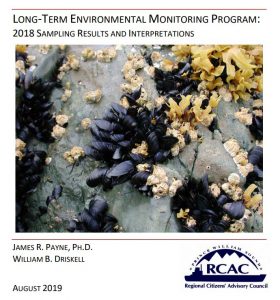 Results from the Council’s efforts to monitor the long-term environmental impacts of the operation of Alyeska Pipeline Service Company’s Valdez Marine Terminal and associated tankers since the Exxon Valdez oil spill have shown oil contamination in Prince William Sound and the Gulf of Alaska has reached all-time low values. The Council has been conducting environmental monitoring since 1993.
Results from the Council’s efforts to monitor the long-term environmental impacts of the operation of Alyeska Pipeline Service Company’s Valdez Marine Terminal and associated tankers since the Exxon Valdez oil spill have shown oil contamination in Prince William Sound and the Gulf of Alaska has reached all-time low values. The Council has been conducting environmental monitoring since 1993.
Alyeska and its owner companies have implemented several improvements over the years which have contributed to the reduction of pollutants being discharged. These include the elimination of single-hulled tankers and Alyeska’s ability to effectively operate their Ballast Water Treatment Facility which removes oil contamination from tanker ballast water.
“The Council’s long-term monitoring program helps fulfill one of our responsibilities under the federal Oil Pollution Act of 1990 and is one of the longest running studies of its kind,” said Donna Schantz, executive director for the Council. “The Council is pleased to be able to recognize, through the results of this study, the efforts and commitment by Alyeska and the Trans Alaska Pipeline System shippers to reduce hydrocarbon releases into the waters of Prince William Sound and the Gulf of Alaska.”
In 2018, three types of samples were retrieved and analyzed from various locations for the study: blue mussels, marine sediments and passive sampling devices (i.e., special plastic strips left in the water to which oil contamination can adhere). After being collected, these samples are sent out to laboratories for chemical analysis. The labs measure and report the various types of oil contamination in each sample. After the lab analysis is complete, environmental forensic scientists interpret the data and can identify the source of the oil contamination in some cases. Additionally, the passive sampling devices provide water quality information that is relevant when considering the potentially toxic impacts of low levels of oil contamination on sensitive life stages of marine life such as salmon and herring embryos.
The Council’s 2018 monitoring was noteworthy because of the geographic range of sampling. In most years the council limits its monitoring to Port Valdez, but every five years the sampling locations are expanded throughout Prince William Sound and the Gulf of Alaska, largely following the path of the Exxon Valdez oil spill. The monitoring in Port Valdez is mostly focused on assessing the environmental impacts of the Valdez Marine Terminal while the monitoring elsewhere is focused on assessing the impacts of oil tankers, including possible lingering oil from the Exxon Valdez spill. In addition to sites that were heavily oiled in 1989, the monitoring is also done at clean, unoiled control sites for comparison.
The 2018 samples showed overall oil contamination in the sampled region was very low. The oil concentrations measured in all the mussel tissue samples were below laboratory detection limits. The oil contamination measured with the passive sampling devices was below any known toxicity thresholds for sensitive marine organisms, such as pink salmon embryos. Compared to the historic range, dating back to 1993, oil concentrations in the marine sediments near the Valdez Marine Terminal and a clean control site were also low in 2018.
The detailed results of the Council’s 2018 environmental monitoring work can be found in the report:
Long-Term Environmental Monitoring Program: 2018 Sampling Results and Interpretations